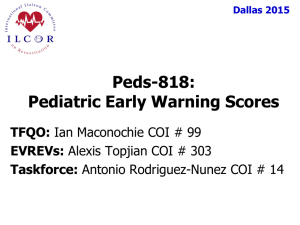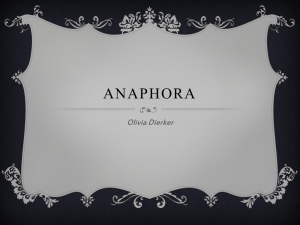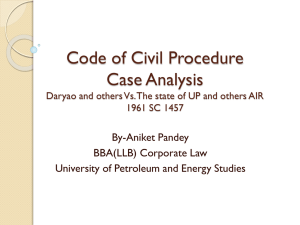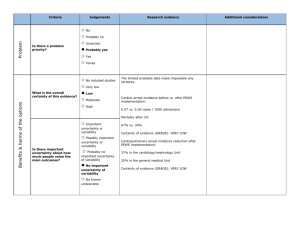read here - Diocese of Lichfield
advertisement
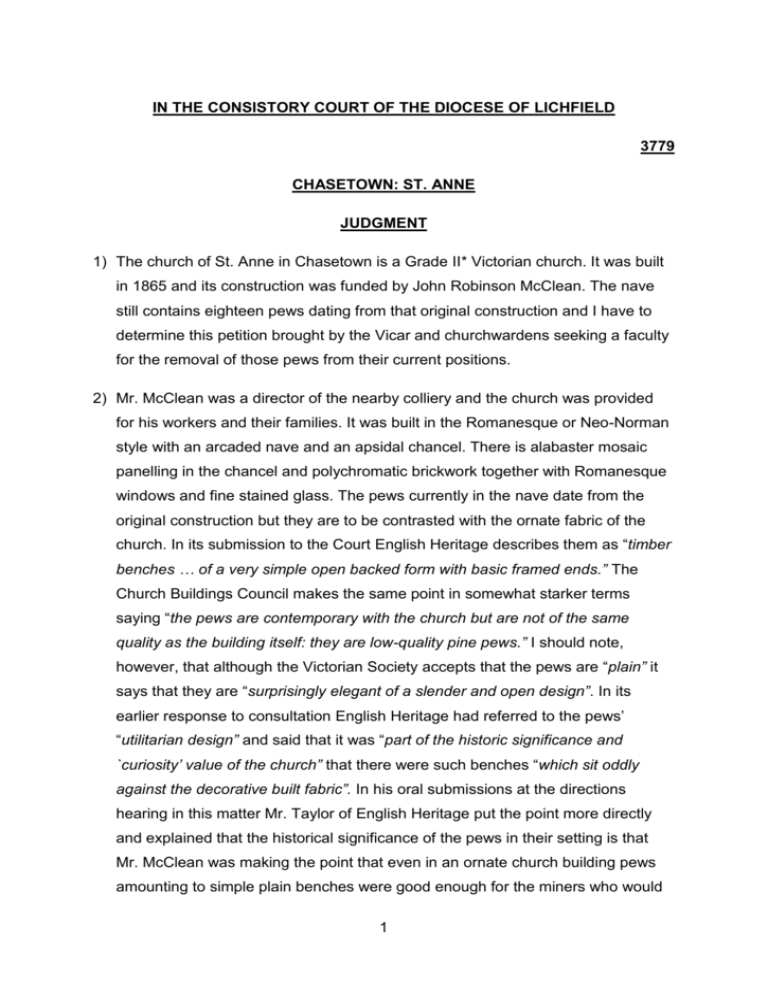
IN THE CONSISTORY COURT OF THE DIOCESE OF LICHFIELD 3779 CHASETOWN: ST. ANNE JUDGMENT 1) The church of St. Anne in Chasetown is a Grade II* Victorian church. It was built in 1865 and its construction was funded by John Robinson McClean. The nave still contains eighteen pews dating from that original construction and I have to determine this petition brought by the Vicar and churchwardens seeking a faculty for the removal of those pews from their current positions. 2) Mr. McClean was a director of the nearby colliery and the church was provided for his workers and their families. It was built in the Romanesque or Neo-Norman style with an arcaded nave and an apsidal chancel. There is alabaster mosaic panelling in the chancel and polychromatic brickwork together with Romanesque windows and fine stained glass. The pews currently in the nave date from the original construction but they are to be contrasted with the ornate fabric of the church. In its submission to the Court English Heritage describes them as “timber benches … of a very simple open backed form with basic framed ends.” The Church Buildings Council makes the same point in somewhat starker terms saying “the pews are contemporary with the church but are not of the same quality as the building itself: they are low-quality pine pews.” I should note, however, that although the Victorian Society accepts that the pews are “plain” it says that they are “surprisingly elegant of a slender and open design”. In its earlier response to consultation English Heritage had referred to the pews’ “utilitarian design” and said that it was “part of the historic significance and `curiosity’ value of the church” that there were such benches “which sit oddly against the decorative built fabric”. In his oral submissions at the directions hearing in this matter Mr. Taylor of English Heritage put the point more directly and explained that the historical significance of the pews in their setting is that Mr. McClean was making the point that even in an ornate church building pews amounting to simple plain benches were good enough for the miners who would 1 be sitting on them. I note that the List Entry Description of the interior of this church makes no mention of the pews. 3) In 1985 there was a reordering of the West End of the church creating a new suite of rooms and a prominent staircase to the upper level. The Petitioners and English Heritage are agreed that this was not a successful move. The Petitioners point out that the re-ordering wasted space and compromised much of the original character of the West End without providing the kind of facilities which the church now needs. English Heritage echoes these concerns referring to the new suite being poorly designed and as detracting from the appearance of the church. The Faculty Application and Its Rationale. 4) The Petition is brought by the Vicar and churchwardens and has the support of the majority of the Parochial Church Council though as will be seen there is opposition from some committed members of the worshipping body and from some in the wider community. 5) The Petitioners seek a faculty for the removal of the eighteen full-length pews from their current position in the nave. They propose that nine of these be shortened to two-thirds of their current length and then be moved into the south aisle to create a separate Lady Chapel focused on the side altar already there. The Petitioners propose that five full length pews should be retained with three of these being positioned as side benches around the north aisle and a further two being used at the west end of the church. The faculty sought would accordingly provide for the nave being cleared of the pews currently in it. 6) One significant feature of the Petition is that the Petitioners do not set out any proposal as to what would replace the pews if the faculty were to be granted. This is a deliberate decision on the part of the Petitioners. They are frank in saying that they wish to undertake a major reordering of the church and that they do not have in mind simply the removal of the pews. However, they are also frank in saying that they see no point in engaging in the exercise of drawing up proposals for a major reordering if they are not to get permission to remove the pews. In essence it is their position that unless they know that they will be able to remove the pews any reordering will be futile and they would not want even to consider 2 such an exercise. The strength or weakness of that approach is a matter I will have to consider below. The Procedural Progress of the Case. 7) The public notice and newspaper advertisement of the Petition resulted in fortytwo letters of objection and twelve of support in addition to the representations from English Heritage, the Victorian Society, and the Local Planning Authority as set out below. Moreover, the Diocesan Advisory Committee consulted the Church Buildings Council which has helpfully set out its assessment of this case. 8) Initially Mrs. Stella Jennings indicated that she wished to become a party to the proceedings. The Petitioners took a point as to her entitlement to become a party and on 30h January 2013 I ruled that Mrs. Jennings had a sufficient interest within the meaning of Rule 16 (1)(g) of the Faculty Jurisdiction Rules 2000 to become a party. However, Mrs. Jennings subsequently indicated that she did not wish to become a party. She and the others who wrote objecting to the Petition were content for me to take their letters into account. Similarly neither the Victorian Society nor the Local Planning Authority wish to become parties. English Heritage did elect to become a party opponent. 9) On 11th March 2013 I held a directions hearing at the church. At that hearing the Petitioners and English Heritage through Mr. Taylor indicated that they were prepared for the matter to be determined by way of written representations. They both subsequently confirmed this in writing (I had already determined that this was an expedient course) and then provided helpful written submissions. At the hearing the Petitioners and Mr. Taylor summarised the issues as they perceived them. Immediately after the hearing I was shown the salient features of the church by the Petitioners (together with Mr. Martin, the church architect) and Mr. Taylor. The Applicable Approach. 10) St. Anne’s is a listed church and the removal of the pews will cause a material alteration in its appearance potentially harming its character as a building of special architectural or historic interest. In those circumstances I adopt the 3 approach recommended by the Court of Arches at paragraph 87 of Duffied: St. Alkmund [2013] 2 WLR 854 of asking: a) Would the proposals, if implemented, result in harm to the significance of the church as a building of special architectural or historic interest? b) If not have the petitioners shown a sufficiently good reason for change to overcome the ordinary presumption that in the absence of a good reason change should not be permitted? c) If there would be harm to the significance of the church as a building of special architectural or historic interest how serious would that harm be? d) How clear and convincing is the justification for carrying out the proposals? e) In the light of the strong presumption against proposals which will adversely affect the special character of a listed building will the benefit outweigh the harm? 11) In considering the last question I have to bear in mind that the more serious the harm the greater the level of benefit needed before proposals can be permitted. I also have to bear in mind that serious harm to a church listed as Grade I or Grade II* should only be permitted in exceptional cases. The Arguments in Favour of the Petition. 12) The Petitioners contend that there is a need for a re-ordering which would involve the removal of the pews from the nave. They explain that the church does not have a church hall and that if there are to be community activities these must take place in the body of the church. There is currently an impressive range of community use. Various groups meet in the church these include a Carer and Toddler group and art and sewing groups. The church hopes to increase community use of the church building seeing this as an important part of its mission and outreach. Added force is given to this desire from the fact that (as is noted in the report of the Diocesan Advisory Committee’s site visit) that the church is the largest public building in the vicinity and so there is no alternative venue for many community activities nor an alternative venue in which the church community can minister to the wider local community. The groups which currently 4 meet in the church are restricted in their activities by the presence of the pews and this is particularly so in the case of activities involving children and young people. The Petitioners set out a number of community uses which would be possible if the nave were cleared of fixed pews. In addition they say that the removal of the pews would enable flexibility in the use of different configurations for worship and would facilitate activities such as “Messy Church” or various aspects of “Fresh Expressions” in worship. In short their point is that the presence of fixed pews filling the nave precludes flexible use of that space and that this, in turn, substantially reduces the usefulness of the church building for worship and mission. 13) The Petitioners and their supporters do not see the removal of the pews as standing alone nor as the end of a process. Rather they see it as part of a more general reordering to achieve the objectives set out above. The decision to seek a faculty in relation to the pews alone was a deliberate one. The Petitioners explain that it had been their original intention to bring forward comprehensive proposals but that they became concerned following the Diocesan Advisory Committee’s site visit in early 2012. During that visit the Amenity Society’s representative on the Committee expressed the view that the removal of the pews from the nave was problematic. The Petitioners see the removal of the pews as crucial to any effective reordering. Mr. Martin says that “however the building is reordered the large clear space that [the Petitioners] need cannot be formed in any way other than by removal of the pews – there simply is not enough alternative space beyond the pewed area.” 14) The Petitioners were reluctant to incur the expense of drawing up detailed proposals or to make the necessary commitment of time and energy if any reordering proposal would be likely to founder on issue of removal of the pews. The Petitioners accept that approval of proposals for an overall reordering would be needed before the pews could actually be moved. They would be prepared to accept conditions to that effect. Nonetheless their position is that they need to know that the pews could be removable in principle before committing themselves further. 5 15) The supporting letters come from those expressing themselves to be (as I accept to be the case) active in the life of St. Anne’s and focus on the relevance of community use to the church’s mission and the difficulties posed for such use by the presence of the pews. 16) The Petitioners say that a number of the pews will remain and that this will enable the historic point about the contrast between the high quality and ornate decoration of the building on the one side and the low quality and utilitarian nature of the pews. The Arguments of those opposing the Petition. 17) English Heritage has objected to the Petition and through Mr. Taylor it has provided submissions which are moderate in tone and well-reasoned. English Heritage accepts that the pews are not of particularly high quality in themselves. Nonetheless, that body points out the contrast between the pews and the rest of the church building as being a real element in the church’s character as a place of special historic and architectural interest. English Heritage does state that it would not be opposed to a substantial reordering in principle. Indeed Mr. Taylor stated English Heritage was sympathetic to the aspiration of a more flexible use of the nave floor space and to proposals that would address the effects of the previous unfortunate reordering of the west end. This sympathy and the acceptance in principle of the need for some change is balanced by concern as to the lack of detail in the current proposals. The core of English Heritage’s opposition to the current proposal is the lack of detailed replacement proposals and the absence of a sufficiently detailed case to justify the change. The point is made that St. Anne’s is a Grade II* church and that a compelling case needs to be made out if there is to be a change. That compelling case should involve, English Heritage says, detailed reasoning justifying the change together with an explanation of what it is proposed would replace the pews and a setting of such proposals in the context of a wider consideration of the reordering of the church as a whole. 18) English Heritage’s point is powerfully and shortly made at paragraph 5.5 of that body’s written submissions. The present petition is said to be “premature”. The contention is that “Reordering of the seating in the nave will cause harm to the 6 significance of the listed building but without a wider view of the future use of the building it is not possible to make a proper assessment of any countervailing benefits which might outweigh the degree of harm or equally to see if those benefits might be delivered in another way”. 19) The approach of the Church Buildings Council echoes that of English Heritage. The Council says that it “considered that the parish had the makings of a reasonable case for reordering the building; the case for such work was strong; and the pews were not of great historic interest in themselves. A high-quality reordering scheme had the potential to enhance the interior considerably.” The difficulty, in the view of the Council, lay in the partial nature of the proposal. There had been no detailed consideration given to the replacement chairs and there was not a “holistic scheme for the treatment of the interior”. In those circumstances the Council recommended refusal of the petition although it did provide a number of encouraging indications as to the way in which the interior could be enhanced. The Council went so far as to say that “a faculty cannot authorise the removal of seating without concurrent proposals for replacement.” 20) The Local Planning Authority was consulted. Its position was expressed in short terms and not entirely clearly. However, the core position seems to be that Lichfield DC supports the position of English Heritage. It is not opposed to a reordering in principle but does not believe that a sufficiently compelling case has been put forward in support of the Petition. 21) The Victorian Society takes a rather firmer line. I have already said that it commented on the elegance of the pews. It said that the visual contribution made by the pews to the interior of St. Anne’s was “perhaps of equal value” to the historical significance of the church. It accepted a need for an increased degree of flexibility on the part of the church but said that the proposed scheme went too far. The Society made the powerful point that in practice a majority of the church’s seating would rarely be moved and that moveable pews would serve as well as chairs to provide flexibility. It says that it would not object to the pews being made moveable but that if this were to be done there would be adequate provision for the church’s needs. 7 22) I have already said that there were forty-two individual letters of objection. The writers include both those active in the life of the church (including Anita Brooks who is the PCC secretary”) and those whose involvement is less direct. A number of the letters refer to stacking chairs and set out opposition to the introduction of such chairs. The Petitioners say that this was a response to an article in the local newspaper entitled “Stacking chairs could replace church pews”. The Petitioners go on to say that the grant of the faculty would not lead to the introduction of stacking chairs and that the replacement furniture would be a matter for a further petition. The position appears to involve a misunderstanding of the effect of the grant of the faculty sought. It would not justify the installation of such chairs and a further faculty would be needed. However, the Petitioners are wrong to suggest that the references to stacking chairs are simply the result of scare stories. The Statement of Need did refer to such chairs and gave the impression that this would be the Petitioners’ preferred approach to replacement seating when that fell to be considered. 23) Some of these letters also refer to the historical integrity of the building being damage by the removal of the pews. Others refer to the need to create and maintain an atmosphere of reverence and to ensure that anything which is introduced into a church is compatible with its status as a place of worship. Assistance from the Diocesan Advisory Committee and the Archdeacon. 24) The Diocesan Advisory Committee has recommended approval of the Petition. Its certificate records that in July 2012 the Committee debated the matter at length and concluded that “there was a compelling need to remove the pews from the nave and that the proposal to preserve a rack of pews in the Lady Chapel went a long way to ensuring that they could be appreciated by future visitors and users.” Initially the Diocesan Advisory Committee’s support for the Petition was qualified in that it wished attempts to be made to preserve more full length pews (rather than the cut down versions to be used in the Lady Chapel). This led to the proposal that five full length pews should be retained and this, in turn, led to the Committee’s support for the Petition. 25) At the time of the presentation of the Petition and until his recent retirement the Ven. Chris Liley was Archdeacon of Lichfield. He expressed his support for the 8 Petition both orally at the directions hearing and in writing. He explained that the church is a large building for a parish without a church hall and that for the parish to be able to use the church flexibly and for community use would assist in securing the future of the church (both in the sense of the building and in that of a worshipping community). The Archdeacon had assessed the strength of feeling on the matter and reported that the majority of the regular congregation supported the proposals. The views of such a majority are, of course, not conclusive and the arguments of those objecting are to be judged on their merits but it is relevant to note that the proposals represent the settled wishes of that majority. Analysis. 26) Will the proposed works cause harm to the significance of the church as a building of special architectural or historic interest and if so how serious will such harm be? There will be harm as has been pointed out by the Diocesan Advisory Committee. There will be a marked change to the internal appearance of the church and that change will impact on the integrity of the internal appearance by removing the pews which were contemporaneous with the fabric of the church. 27) That will undoubtedly be a real harm to the significance of the church but how serious that harm will be is less clear-cut. In that regard I note that the pews are not mentioned in the listing description. I also note that the historical integrity has already been affected by the 1985 reordering. 28) I agree with the Victorian Society that the retention of some of the pews in a cut down version forming a Lady Chapel in the south aisle will not prevent there being a real impact on the church’s historic appearance. That Society is right to say that this “would not suffice to preserve the original rhythm and original aesthetic of the pewed church”. However, I regard it as highly significant that English Heritage and the Church Buildings Council while urging refusal of the Petition place the emphasis elsewhere and do not focus on the impact on the appearance of the church. The former’s concern relates to the need for a holistic treatment of the interior of this church. The latter’s concern about removal of the pews is not as to their contribution to the appearance and the visual character of the church but as to the historic significance of the contrast between the utilitarian 9 construction of the pews and the ornate fabric of the building. This contrast would remain visible if some of the pews were retained in the south aisle. Both English Heritage and the Church Buildings Council have said in terms that a reordering involving the removal of the pews would be acceptable in principle and this is also the advice of the Diocesan Advisory Committee. 29) I have concluded that there will be real harm to the church’s significance but that it will not be such as to remove the church’s special character. As the listing description makes clear and is readily apparent on entering St. Anne’s the church’s character as a building of special architectural and historical interest derives not from the presence of the pews nor even from their combination with the fabric but principally from the structure and fabric of the building. 30) In the light of that finding as to the existence of real harm I have to consider the strength of the justification for the removal of the pews and whether that outweighs the harm which will result. 31) There is general agreement that the current position of the pews hinders flexible use of the interior of the church. I accept the submissions of the Petitioners supported as they are by the Archdeacon that such flexible use is an important part of the mission of St. Anne’s in serving the local community; that it is also important in enabling different forms of worship; and that it will be an element in securing the future of the building. The absence of a church hall means that if St. Anne’s is to provide facilities for community use such facilities must be provided in the church. Moreover, the absence of other large public buildings in the locality confirms that by providing such facilities the church will be meeting a real need. Those elements of community use and activities ancillary to worship which currently take place in the church are less satisfactory than they would otherwise be because of the constraints imposed by the presence of the pews. I am very much influenced by the assessment of the Diocesan Advisory Committee that there is “a compelling need to remove the pews from the nave”. 32) I am also note that with the exception of the Victorian Society all the professional bodies are agreed that a significant reordering is desirable and would be appropriate. Such a reordering would not only enable enhanced use of the 10 church but would enable the replacement or modification of the works carried out in 1985 and an amelioration of their harmful effect. 33) The Victorian Society says that a degree of flexibility could be achieved by making the pews moveable (which all are agreed would be practicable). The Society’s contention is that this markedly less drastic change than is proposed by the Petitioners could achieve flexibility without the impact on the appearance of the church which would result from the removal of the pews. The Society also makes the point that although a desire for flexibility is often put forward as a justification for the removal of pews it is often the case that the replacement seating is rarely moved. Thus pews are removed and replaced by different seating which remains in the same configuration throughout the year. 34) I have concluded that simply making the pews moveable would not adequately address the needs of the church and would not be a solution to the problems being encountered in the use of St. Anne’s. The pews are long and there is very little spare space around them. Thus even if they were to be made moveable their presence would markedly impede flexible use of the nave. If there is to be a reordering which is to be anything other than a minor tinkering with the interior the pews will need to be replaced. In particular this is the case if there is to be a reordering which enables the nave to be used flexibly. 35) The key arguments against the Petition from English Heritage and the Church Buildings Council are to say that it is premature; that there is a lack of substantiation as to what is to replace the pews; and that a faculty should not be granted merely allowing removal of the pews. In addition those who have written letters of objection have expressed concern about the prospect of stacking chairs and this is linked (both expressly and impliedly) with a concern that the appearance of the church’s interior will be less seemly and an atmosphere of reverence will be lost. 36) What is the effect of the fact that the Petitioners have not put forward more detailed proposals? Is the Petition for removal of the pews to be dismissed because the details of the replacement seating and its setting in the context of a wider reordering are not provided? The Petitioners’ reluctance to commit to the 11 expense and energy involved in formulating more wide-ranging proposals until they know whether the removal of the pews will be permitted is understandable. For such proposals to be formulated will involve not only expense but if the proposals are to be prepared properly and are to be properly considered will require also considerable commitment of time and energy on the part of the Parochial Church Council. I have already explained that removal of the pews will be necessary if there is to be any substantial reordering. It follows that the drawing up of wide-ranging proposals would be so much wasted effort if the end result is a refusal to allow the pews to be moved. Nonetheless, the absence of fully worked up proposals is a serious difficulty. It makes it much more difficult for the Court to see the benefits of a substantial reordering and also more difficult to see the extent of the harm to the character of the church. This, in turn, means that it is much more difficult to decide whether the benefit is such as to justify the harm. Moreover, the burden is on a petitioner to show that a proposed change is justifiable and to require fully worked up proposals would be a salutary reminder of the need to ensure that only justifiable changes are to be permitted. Moreover, if there had been fully worked up proposals it may well be that many of the concerns of those who have written letters of objection would have been assuaged. Many of those concerns with their references to a lack of reverence and an anxiety about stacking chairs might have fallen away if the Petitioners had brought forward detailed proposals explaining what would become of the interior of the church after the removal of the pews. 37) What should the Court do when faced with such a situation? It is my judgment that the Church Buildings Council states the position too starkly when saying that “a faculty cannot authorise the removal of seating without concurrent proposals for replacement.” Of course, seating needs to be provided in the nave and fresh seating cannot be introduced without a faculty. Canon F7 paragraphs 1 & 3 require that seats are to be provided for the use of those attending divine service and that parishioners have a right to seats in the main body of the church. Clearly a faculty could not be granted which would give rise to a breach of that requirement. For the Court to grant a faculty for the removal of pews without any replacement provision being made would be inappropriate. However, that is not the position here. The Petitioners have explained that they would be content for 12 any faculty to be subject to conditions as to its implementation and would be willing to await approval of a more general reordering before removing the pews. 38) If a faculty were to be granted in the circumstances here it would be subject to conditions as to its implementation with a view to ensuring that the pews were only removed as part of a high quality reordering scheme (though perhaps one carried out in a number of phases). The choice, therefore, is not between refusal of the Petition and granting a bare faculty for the removal of the pews. It is a choice between refusal and granting the faculty which the Petitioners seek but with conditions attached to it. It is clear that if the removal of the pews from the nave were to be part of a general reordering of high quality then the benefits would be sufficient to outweigh the harm to the special character of the church. That is accepted by both English Heritage and the Church Buildings Council. Indeed, they indicate that they would support such a scheme. The benefits of such a scheme would be the enabling of a more flexible use of the church and the amelioration of the effects of the previous reordering. In such a context the historical interest arising from the utilitarian nature of the pews would not countervail against the benefits. It would border on the perverse to say that those currently using the church should continue with unsuitable seating because the presence of that seating demonstrates what a Victorian mine owner regarded as suitable for his miners. In this context considerable weight attaches to the Diocesan Advisory Committee’s support for the Petition and to that body’s view that there is a compelling need to remove the pews. 39) It follows that removal of the pews in the context of a high quality and welldesigned reordering would be acceptable. Should the Court approach the matter on the footing that a faculty can be granted if the Court can by the use of conditions ensure that the proposed works are part of an acceptable whole? In the context here can I use conditions to justify the grant of a faculty for the bare removal of pews when such a removal would be unacceptable without the conditions? Conversely should the Court say that the burden is on the Petitioners and that it is for them to bring forward acceptable proposals and not for the Court to gloss over the inadequacies of the Petition by providing conditions? I have concluded that I am entitled to take account of the fact that the concerns 13 expressed about a bare removal of pews can be met by conditions limiting the circumstances in which such removal can take place. I reach that conclusion because it is a common feature of the faculty process that proposals are brought forward in a petition and that a view is expressed by English Heritage, an amenity society, or a diocesan advisory committee that the proposals would be acceptable if particular conditions were to be imposed. In such circumstances the Court does not say that the Petition is to be dismissed but instead it typically grants the faculty sought but imposes conditions such as recommended by those with specialist knowledge. Of course different considerations arise where particular petitioners dispute the appropriateness of suggested conditions but that is not the position here. Here the Petitioners have accepted from the outset that the removal of the pews should not occur in isolation and have accepted that conditions as to the implementation of the faculty should be imposed. 40) I have concluded that appropriate conditions mean that the Court and those concerned about St. Anne’s can be confident that the removal of the pews will not take place unless and until appropriate reordering proposals have been put forward and approved. The Petitioners can proceed to consider a more general reordering knowing that their proposals will not fall at the hurdle of pew removal but others will know that the pews will only be removed in the context of a high quality scheme for a more wide-ranging reordering of the interior of the church. In addition I will impose a time limit of two years within which the works authorised by the faculty must start intending by this to enable time for further proposals to be properly and carefully formulated but also ensuring that if prompt action is not taken or if no general acceptable reordering scheme is brought forward the permission will lapse. 41) The conditions which I intend to impose are that: a) The works authorised by the faculty shall not commence until after the grant of a further faculty authorising the reordering of the nave and providing for the introduction of seating to replace the pews or further order. b) The works authorised by the faculty shall not be commenced more than two years after the grant of the faculty or such further period as may be ordered. 14 42) I give permission to the Petitioners and to English Heritage to apply as to the wording of the conditions. 43) I will consider any future reordering petition on its merits and in the light of the submissions made if and when such a petition is presented. However, my current thinking (as will be apparent from the foregoing comments) is that any reordering will need to be of high quality in order to be permitted. St. Anne’s is a beautiful church and its people are still living with the consequences of the mistakes made in the 1985 reordering. It is important that any new scheme improves and enhances the church. STEPHEN EYRE 15th June 2013 15


